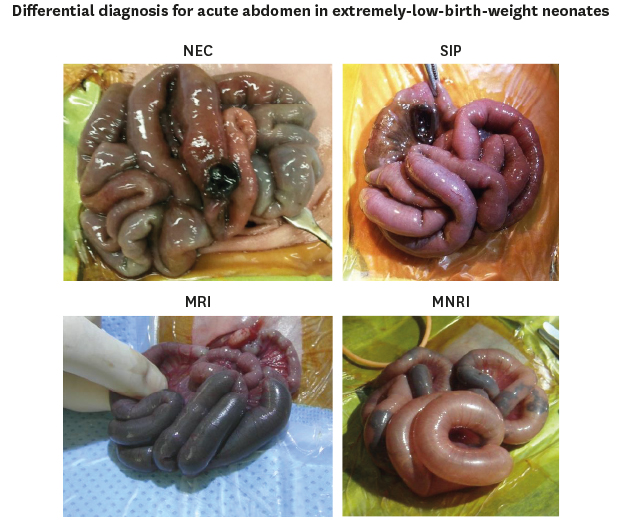1. Fitzgibbons SC, Ching Y, Yu D, Carpenter J, Kenny M, Weldon C, et al. Mortality of necrotizing enterocolitis expressed by birth weight categories. J Pediatr Surg. 2009; 44(6):1072–1075.

2. Patel RM, Kandefer S, Walsh MC, Bell EF, Carlo WA, Laptook AR, et al. Causes and timing of death in extremely premature infants from 2000 through 2011. N Engl J Med. 2015; 372(4):331–340.

3. Shim JW, Jin HS, Bae CW. Changes in survival rate for very-low-birth-weight infants in Korea: comparison with other countries. J Korean Med Sci. 2015; 30:Suppl 1. S25–S34.

4. Stoll BJ, Hansen NI, Bell EF, Shankaran S, Laptook AR, Walsh MC, et al. Neonatal outcomes of extremely preterm infants from the NICHD Neonatal Research Network. Pediatrics. 2010; 126(3):443–456.
5. Committee on Academic Survey and Advanced Medical Science. Neonatal surgery in Japan: national survey on neonatal surgery 2003. J Jpn Soc Pediatr Surg. 2004; 40(7):919–934.
6. Neu J, Walker WA. Necrotizing enterocolitis. N Engl J Med. 2011; 364(3):255–264.

7. Mintz AC, Applebaum H. Focal gastrointestinal perforations not associated with necrotizing enterocolitis in very low birth weight neonates. J Pediatr Surg. 1993; 28(6):857–860.

8. Aschner JL, Deluga KS, Metlay LA, Emmens RW, Hendricks-Munoz KD. Spontaneous focal gastrointestinal perforation in very low birth weight infants. J Pediatr. 1988; 113(2):364–367.

9. Meyer CL, Payne NR, Roback SA. Spontaneous, isolated intestinal perforations in neonates with birth weight less than 1,000 g not associated with necrotizing enterocolitis. J Pediatr Surg. 1991; 26(6):714–717.
10. Kubota A, Imura K, Yagi M, Kawahara H, Mushiake S, Nakayama M, et al. Functional ileus in neonates: Hirschsprung's disease-allied disorders versus meconium-related ileus. Eur J Pediatr Surg. 1999; 9(6):392–395.

11. Kubota A, Shiraishi J, Kawahara H, Okuyama H, Yoneda A, Nakai H, et al. Meconium-related ileus in extremely low-birthweight neonates: etiological considerations from histology and radiology. Pediatr Int. 2011; 53(6):887–891.

12. Baird R, Puligandla PS, St Vil D, Dube S, Laberge JM. The role of laparotomy for intestinal perforation in very low birth weight infants. J Pediatr Surg. 2006; 41(9):1522–1525.

13. Cass DL, Brandt ML, Patel DL, Nuchtern JG, Minifee PK, Wesson DE. Peritoneal drainage as definitive treatment for neonates with isolated intestinal perforation. J Pediatr Surg. 2000; 35(11):1531–1536.

14. Hall NJ, Curry J, Drake DP, Spitz L, Kiely EM, Pierro A. Resection and primary anastomosis is a valid surgical option for infants with necrotizing enterocolitis who weigh less than 1000 g. Arch Surg. 2005; 140(12):1149–1151.

15. Kubota A, Yamanaka H, Okuyama H, Shiraishi J, Kawahara H, Hasegawa T, et al. Focal intestinal perforation in extremely-low-birth-weight neonates: etiological consideration from histological findings. Pediatr Surg Int. 2007; 23(10):997–1000.

16. Dindo D, Demartines N, Clavien PA. Classification of surgical complications: a new proposal with evaluation in a cohort of 6336 patients and results of a survey. Ann Surg. 2004; 240(2):205–213.
17. Pumberger W, Mayr M, Kohlhauser C, Weninger M. Spontaneous localized intestinal perforation in very-low-birth-weight infants: a distinct clinical entity different from necrotizing enterocolitis. J Am Coll Surg. 2002; 195(6):796–803.
18. Koivusalo A, Pakarinen M, Rintala R. Morbidity after surgical treatment of isolated intestinal perforation and necrotizing enterocolitis is similar in preterm infants weighing less than 1500 g. J Pediatr Surg. 2010; 45(2):319–322.

19. Rickham PP, Boeckman CR. Neonatal meconium obstruction in the absence of mucoviscidosis. Am J Surg. 1965; 109:173–177.
20. Puri P. Variant Hirschsprung's disease. J Pediatr Surg. 1997; 32(2):149–157.

21. Toyosaka A, Tomimoto Y, Nose K, Seki Y, Okamoto E. Immaturity of the myenteric plexus is the aetiology of meconium ileus without mucoviscidosis: a histopathologic study. Clin Auton Res. 1994; 4(4):175–184.

22. Gfroerer S, Fiegel H, Schloesser RL, Rolle U. Primary laparotomy is effective and safe in the treatment of necrotizing enterocolitis. World J Surg. 2014; 38(10):2730–2734.

23. Zani A, Pierro A. Necrotizing enterocolitis: controversies and challenges. F1000 Res. 2015; 4:F1000 Faculty Rev-1373.

24. Adderson EE, Pappin A, Pavia AT. Spontaneous intestinal perforation in premature infants: a distinct clinical entity associated with systemic candidiasis. J Pediatr Surg. 1998; 33(10):1463–1467.

25. Blakely ML, Gupta H, Lally KP. Surgical management of necrotizing enterocolitis and isolated intestinal perforation in premature neonates. Semin Perinatol. 2008; 32(2):122–126.

26. Chung SH, Bae CW. Improvement in the survival rates of very low birth weight infants after the establishment of the Korean neonatal network: comparison between the 2000s and 2010s. J Korean Med Sci. 2017; 32(8):1228–1234.










 PDF
PDF Citation
Citation Print
Print





 XML Download
XML Download